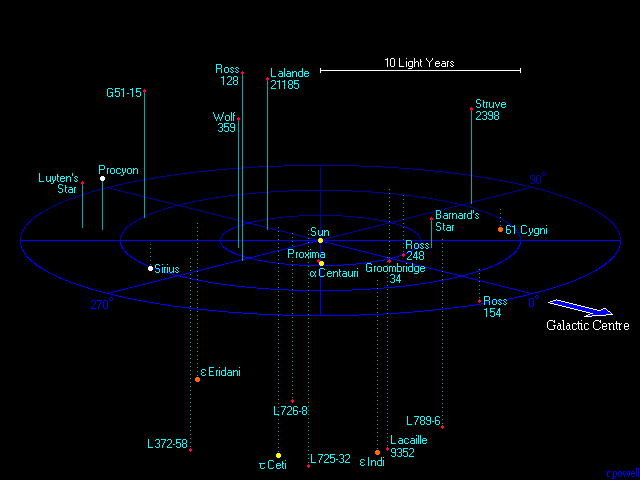The Universe within 12.5 Light Years
The Nearest Stars
 Number of stars within 12.5 light years = 33 Number of stars within 12.5 light years = 33 |
About the Map
This map shows all the star systems that lie within 12.5
light years of our Sun. Most of the stars are red dwarfs - stars with a tenth of
the Sun's mass and less than one hundredth the luminosity. Roughly eighty percent
of all the stars in the universe are red dwarfs, and the nearest star - Proxima - is
a typical example.
| Additional Maps |
|---|
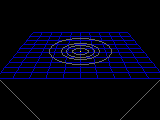 |
This is a diagram that zooms out from the Earth's orbit to the nearest star
system. It tries to show just how large the distance to the nearest star
really is. |
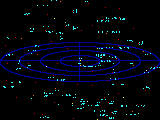 |
Here is a map of all the known stars that lie within 20 light years plotted
using the data provided below. |
| Data and Catalogs |
|---|
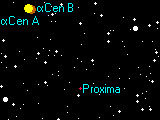 |
There are over 100 stars within 20 light years. This is a list of the
known stars that lie within this distance. |
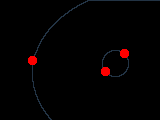 |
This is a page showing some simple animations of double, triple and
quadruple star systems, to demonstrate how stars orbit each other. |
Information on the Nearest Stars
- Sun - Type=G2, Magnitude=-26.8, Distance=0.0000158 ly
- A typical yellow dwarf star. It has eight planets orbiting it.
- Proxima Centauri - Type=M5, Magnitude=11.0, Distance=4.22 ly
- This dim red dwarf is the nearest star to the Sun, and it is a member of the
Alpha Centauri system despite lying 0.24 light years from the main
pair of stars, requiring over one million years to orbit them. Proxima was
discovered in 1915 by Robert Innes and was at that time the least luminous
star known. It is also a flare star - capable of brightening a magnitude
or more in minutes.
- Alpha Centauri A,B - Type=G2+K0, Magnitudes=0.0+1.4, Distance=4.39 ly
- Just slightly further from us than Proxima, lie the orange and yellow
dwarf stars that make up Alpha Centauri. Orbiting each other in an 80
year period, together they make up one of the brightest objects in southern
hemisphere skies. Seen from Alpha Centauri, the third member of the system,
Proxima, is a dim (magnitude 4.8) star.
- Barnard's Star - Type=M5, Magnitude=9.6, Distance=5.94 ly
- Famous for having the largest proper motion of any star, this dim red dwarf
travels 0.29 degrees against the background sky in a century. Discovered
by E Barnard in 1916, it was thought in the 1960's to have a couple of
unseen planets orbiting it, but later observations disproved this. In
another 8000 years Barnard's Star will become the closest star to us.
- Wolf 359 - Type=M6, Magnitude=13.5, Distance=7.80 ly
- An excessively dim red dwarf discovered by Max Wolf in 1918. For 25
years it was the least luminous star known.
- Lalande 21185 - Type=M2, Magnitude=7.5, Distance=8.31 ly
- Recorded in JJ Lalande's star catalogue compiled in the 1790's, this is one of
the brightest red dwarfs in the sky, but it still needs binoculars to see
it. G Gatewood reported in 1996 the possible indications of a couple of Jupiter
sized planets orbiting it but this remains unconfirmed.
- Sirius A,B - Type=A1+DA, Magnitudes=-1.4+8.4, Distance=8.60 ly
- This brilliant white star is the brightest star in the night sky and the
most luminous star within 25 light years. Its white dwarf companion was first
seen in 1852, the first white dwarf ever seen. The orbital period is 50
years.
- Luyten 726-8 A,B - Type=M5+M5, Magnitudes=12.4+13.3, Distance=8.73 ly
- This is a dim binary system consisting of two red dwarfs. The system is
perhaps more famously known as UV Ceti, the variable-star name of the second
star in the system. It is a famous flare star and can visibly brighten by
several magnitudes as it ejects flares from its surface similar to the ones
seen on the surface of the Sun, but far more energetic. Both stars require
about 200 years to orbit each other.
- Ross 154 - Type=M4, Magnitude=10.4, Distance=9.69 ly
- A dim red dwarf. It is one of a number of nearby stars catalogued by
Frank Ross in the 1930's. It is also a known flare star.
- Ross 248 - Type=M6, Magnitude=12.3, Distance=10.33 ly
- Another dim red dwarf.
- Epsilon Eridani - Type=K2, Magnitude=3.7, Distance=10.50 ly
- An orange dwarf star. This star was searched for signs of intelligent life
with the Green Bank radio telescope in 1960. The results, predictably, were
negative. The IRAS satellite detected a lot of dust orbiting this star indicating
a possible forming solar system, and even more recently, (Aug 2000), a Jupiter
sized planet has been detected orbiting this star at a distance of 3.2 AU
(480 million km).
- Lacaille 9352 - Type=M2, Magnitude=7.4, Distance=10.73 ly
- A fairly bright red dwarf which can easily be seen with binoculars, it was
first recorded in Nicolas de Lacaille's catalogue of southern hemisphere stars
compiled around 1752.
- Ross 128 - Type=M4, Magnitude=11.1, Distance=10.89 ly
- A dim red dwarf, also known as FI Vir - its variable star designation.
- Luyten 789-6 A,B,C - Type=M5+M5+M7, Magnitudes=13.3+13.3+14.0, Distance=11.1 ly
- There seems to be three red dwarfs in this system. The main pair orbiting
each other in a 2 year period, and a dim third star orbiting the first at a
very close range.
- Procyon A,B - Type=F5+DA, Magnitudes=0.4+10.7, Distance=11.41 ly
- A brilliant yellow-white star, and the eighth brightest star in the sky. With
twice the diameter of the Sun, Procyon is also the largest star within 25 light
years. Procyon is orbited by a white dwarf companion first seen optically in 1896.
The orbital period is 41 years.
- 61 Cygni A,B - Type=K5+K7, Magnitudes=5.2+6.1, Distance=11.41 ly
- This binary system of two orange dwarf stars is famous for being the first
star ever to have its distance measured by F Bessel in 1838. Both stars are
very similar but are widely separated (86 AU) requiring about 700 years to orbit
each other.
- Struve 2398 A,B - Type=M4+M5, Magnitudes=8.9+9.7, Distance=11.6 ly
- A binary system of two red dwarfs named Struve 2398 from a catalogue of
double stars published in 1827. This system is also known by the rather
more boring name of BD+59°1915. The two stars are quite widely separated
(50 AU) and orbit each other in a 450 year period.
- Groombridge 34 A,B - Type=M2+M6, Magnitudes=8.1+11.1, Distance=11.64 ly
- Another pair of red dwarfs, this system is usually called Groombridge 34
from an 1838 catalogue of northern stars or sometimes BD+43°44. Both stars
are variable in brightness and have the variable star names of GX And and
GQ And. Both stars lie far apart from each other (150 AU) and orbit each
other in a 2500 year period.
- Giclas 51-15 - Type=M6, Magnitude=14.8, Distance=11.8 ly
- This excessively dim red dwarf is the least luminous star within
14 light years. It shines with just 0.01% of the Sun's luminosity.
- Epsilon Indi A,B,C - Type=K5+T1+T6, Magnitude=4.7, Distance=11.83 ly
- An orange dwarf. It is a similar star to Epsilon Eridani, although a
little bit smaller and dimmer. Epsilon Indi is orbited by a pair of brown dwarfs -
failed stars that are too small to burn. They were discovered in 2003 and they
orbit each other in a 16 year period, and they are 1500 AU (220 billion km) from
the main star and they require about 70 000 years to orbit it.
- Tau Ceti - Type=G8, Magnitude=3.5, Distance=11.90 ly
- The nearest, single, sun-like star. It was searched (unsuccessfully) for
any signs of intelligent life in 1960, along with Epsilon Eridani.
- Luyten 372-58 - Type=M5, Magnitude=13.0, Distance=12.1 ly
- A very dim red dwarf. Although this star was catalogued decades ago, it
has only recently had its distance determined with any accuracy.
- Luyten 725-32 - Type=M5, Magnitude=12.1, Distance=12.1 ly
- Another dim red dwarf.
- Luyten's Star - Type=M3, Magnitude=9.8, Distance=12.39 ly
- A red dwarf. It is named after Willem Luyten who realised it was a nearby star
in 1935. The star lies just 1.2 light years away from Procyon, but it is not
associated with it.
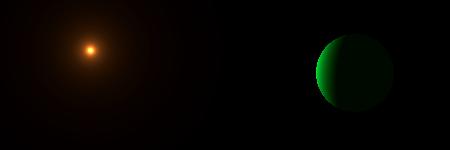
Epsilon Eridani is orbited by a large planet which might look like this.
